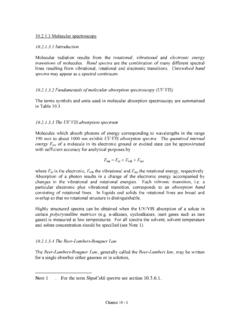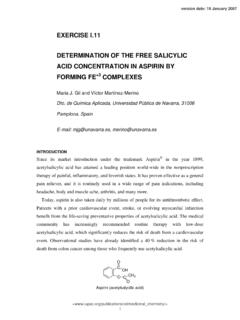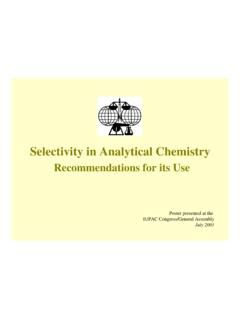Transcription of Principles of Chemical Nomenclature
1 Principles of Chemical Nomenclature A GUIDE TO. IUPAC RECOMMENDATIONS. Principles of Chemical Nomenclature A GUIDE TO. IUPAC RECOMMENDATIONS. LEIGH OBE. The School of Chemistry, Physics and Environmental Science, University of Sussex, Brighton, UK. FAVRE. Universit de Montr al Montr al, Canada METANOMSKI. Chemical Abstracts Service Columbus, Ohio, USA. Edited by Leigh b Blackwell Science 1998 by DISTRIBUTORS. Blackweil Science Ltd Marston Book Services Ltd Editorial Offices: P0 Box 269. Osney Mead, Oxford 0X2 0EL. 25 John Street, London WC1N 2BL Abingdon Oxon 0X14 4YN. 23 Ainslie Place, Edinburgh EH3 6AJ. 350 Main Street, Maiden (Orders: Tel: 01235 465500. Fax: 01235 465555). MA 02 148-5018, USA.
2 54 University Street, Carlton USA. Victoria 3053, Australia Blackwell Science, Inc. 10, Rue Casmir Delavigne Commerce Place 75006 Paris, France 350 Main Street Malden, MA 02 148-5018. Other Editorial Offices: (Orders: Tel: 800 759 6102. Blackwell Wissenschafts-Verlag GmbH 781 388 8250. KurfUrstendamm 57 Fax: 781 388 8255). 10707 Berlin, Germany Canada Blackwell Science KK Copp Clark Professional MG Kodenmacho Building 200 Adelaide St West, 3rd Floor 7 10 Kodenmacho Nihombashi Toronto, Ontario M5H 1W7. Chuo-ku, Tokyo 104, Japan (Orders: Tel: 416 597-1616. 800 815-9417. All rights reserved. No part of Fax: 416 597-1617). this publication may be reproduced, Australia stored in a retrieval system, or Science Pty Ltd Blackwell transmitted, in any form or by any 54 University Street means, electronic, mechanical, Carlton, Victoria 3053.
3 Photocopying, recording or otherwise, except as permitted by the UK (Orders: Tel: 3 9347 0300. Fax: 3 9347 5001). Copyright, Designs and Patents Act 1988, without the prior permission of the copyright owner. A catalogue record for this title is available from the British Library First published 1998. ISBN 0-86542-685-6. Set by Semantic Graphics, Singapore Printed and bound in Great Britain Library of Congress by MPG Books Ltd, Bodmin, Cornwall Cataloging-in-publication Data Leigh, G. J. The Blackwell Science logo is a Principles of Chemical Nomenclature : a guide to trade mark of Blackwell Science Ltd, IUPAC recommendations / Leigh, registered at the United Kingdom Favre, Metanomski.
4 Trade Marks Registry cm. p. Includes bibliographical references and index. ISBN 0-86542-685-6. 1. Chemistry Nomenclature . I. Favre, II. Metanomski, III. International Union of Pure and Applied Chemistry. IV. Title. 1997. 540'. 14 dc2i 97-28587. CIP. Contents Preface, vii 1 INTRODUCTION, 1. 2 DEFINITIONS, 3. 3 FORMULAE, 9. Introduction, 9. Empirical formulae, 9. Molecular formulae, 9. Structural formulae, 10. Sequence of citation of symbols, 11. Formulae of groups, 13. Three-dimensional structures and projections, 16. Isomers and stereoisomers, 21. 4 NAMING OF SUBSTANCES, 26. Types of Nomenclature , 26. Binary-type Nomenclature , 27. More complex Nomenclature systems, 49. Coordination Nomenclature , an additive Nomenclature , 51.
5 Substitutive Nomenclature , 70. Functional class Nomenclature , 96. 5 ASPECTS OF THE Nomenclature OF. ORGANOMETALLIC COMPOUNDS, 98. General, 98. Derivatives of Main Group elements, 98. Organometallic derivatives of transition elements, 102. 6 MACROMOLECULAR (POLYMER) Nomenclature , 103. Definitions, 103. General considerations, 104. Source-based Nomenclature , 105. Structure-based Nomenclature , 105. Trade names and abbreviations, 113. V. CONTENTS. 7 BIOCHEMICAL Nomenclature , 114. Introduction, 114. Carbohydrate Nomenclature , 114. Nomenclature and symbolism for amino acids and peptides, 118. Lipid Nomenclature , 121. Steroid Nomenclature , 122. 8 Nomenclature IN THE MAKING, 124. Index, 127.
6 Vi Preface This book arose out of the convictions that IUPAC Nomenclature needs to be made as accessible as possible to teachers and students alike, and that there is an absence of relatively complete accounts of the IUPAC 'colour' books suited to school and undergraduate audiences. This is not to decry in any way the efforts of organisations such as the Association for Science Education (ASE) in the UK, but what we wished to produce was a version of IUPAC rules that would be relatively complete and allow the beginner to explore and learn about Nomenclature as much or as little as desired. Initially, it was intended to produce a book that would cover all IUPAC colour books and encompass much more than what is conventionally regarded as nomen- clature, dealing also with units, kinetics and analysis.
7 A committee consisting of C. J. H. Schutte (South Africa), J. R. Bradley (South Africa), T. Cvita (Croatia), S. Gb (Poland), H. A. Favre (Canada) and G. J. Leigh (UK) was set up to produce a draft of this book. Later, they were joined by W. V. Metanomski (USA). When the first draft had been prepared, it was evident that the conventional Nomenclature section was so large that it unbalanced the whole production. Finally, it was decided to prepare two texts, one following the original proposal, but with a much reduced Nomenclature content in order to restore the balance, and a second, this volume, that would attempt to survey the current IUPAC nomencla- ture recommendations in organic, inorganic and macromolecular chemistry and also include some basic biochemical Nomenclature .
8 This was undertaken by Favre, Leigh and Metanomski, with the final editing being undertaken by Leigh. It is hoped that this volume will more than cover all the Nomenclature require- ments of students at pre-University and early undergraduate levels in most coun- tries. It should also enable University students and teachers to learn the basic Principles of Nomenclature methods so that they can apply them accurately and with confidence. It will probably be too advanced for school students, but should be useful for their teachers. Specialists in Nomenclature recognise two different categories of Nomenclature . Names that are arbitrary (including the names of the elements, such as sodium and hydrogen) as well as laboratory shorthand names (such as diphos and LithAl) are termed trivial names.
9 This is not a pejorative or dismissive term. Trivial nomencla- ture contrasts with systematic Nomenclature , which is developed according to a set of prescribed rules. However, Nomenclature , like any living language, is growing and changing. This is reflected by the fact that IUPAC does not prescribe a single name for each and every compound. There are several extant systems of Nomenclature and many trivial names are still in use. This means that the chemist often has a selection of names from which to choose. IUPAC may prefer some names and allow others, and the name selected should generally be, within reason, a systematic one. Because IUPAC cannot legislate, but can only advise, chemists should feel free to back their own judgement.
10 For example, the systematic name for NH3 is azane, but it is not recommended for general use in place of the usual 'ammonia'. On the other hand, there seems to be no vii PREFACE. good reason why chemists generally should not adopt the more systematic phos- phane, rather than phosphine, for PH3. Students may find this matter of choice confusing on occasion, which will be a pity. However, there are certain long-established Principles that endure, and we hope to have encompassed them in this book. G. J. Leigh University of Sussex June 1997. viii Introduction Chemical Nomenclature is at least as old as the pseudoscience of alchemy, which was able to recognise a limited number of reproducible materials.



